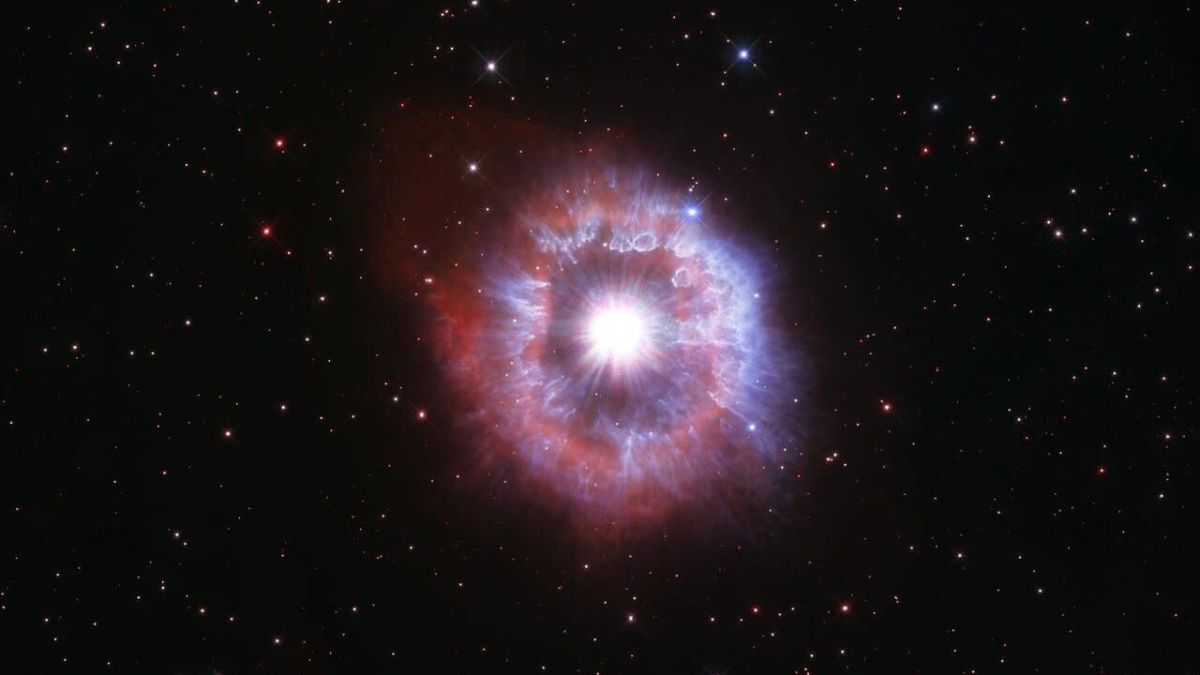
Expanding Cloud From ‘Volcanic’ Star Revealed in New Hubble Image
[ad_1]

On this, the 31st anniversary of the Hubble Space Telescope’s launch, astronomers with NASA and ESA have released a stunning new image to celebrate the achievements of this legendary observatory.
The newly released Hubble image, taken in both visible and ultraviolet light, shows AG Carinae, a Luminous Blue Variable (LBV) star located 20,000 light-years from Earth. This star is absolutely ginormous, containing a mass 70 times greater than our Sun.
Like an eyeball staring back at us, AG Carinae is a giant star surrounded by an expanding cloud of gas and dust known as a nebula. Incredibly, this nebula measures five light-years across—a distance greater than the gap that separates our Sun from Proxima Centauri, our nearest stellar neighbor. AG Carinae endured a violent eruption in its past, resulting in the prominent feature.
The reddish layers of the nebula contain glowing hydrogen gas intermixed with nitrogen gas, while the bluish areas are dense pockets of dust. Winds within the structure are “travelling at up to 1 million kilometres per hour [600,000 mph], about 10 times faster than the expanding nebula,” explains the Hubble press release. “Over time, the hot wind catches up with the cooler expelled material, ploughs into it, and pushes it farther away from the star.” The resulting “snowplow” effect formed the circular cavity seen in the image above.
The rapidly expanding shell is the result of the star’s outer layer being blown into space. The amount of material packed inside the nebula is roughly equal to 10 times the mass of our Sun. LBVs may be among the biggest and brightest stars in the galaxy, but they are exceptionally short lived, expiring after just 5 million to 6 million years. Our Sun, by contrast, is about halfway through its 10-billion-year lifespan.
G/O Media may get a commission
It’s believed that LBV outbursts happen on multiple occasions during a star’s lifetime. The cause has to do with the constant tension between the radiation pressure pushing outward and the immense gravity pulling inward. As the Hubble press release explains, this “arm-wrestling match results in the star’s expanding and contracting,” and the “outward pressure occasionally wins the battle, and the star expands to such an immense size that it blows off its outer layers, like a volcano erupting.” The star survives the big belch, and the process is renewed.
Eventually, however, these stars are likely to meet their fate in a catastrophic supernova, in which the entire structure is blown out into space. Such blasts result in the death of the star, but supernova explosions are the primary source of heavy elements in the universe—meaning humans wouldn’t be here without them.
So happy birthday, Hubble! And keep ‘em coming.
[ad_2]
Source link







